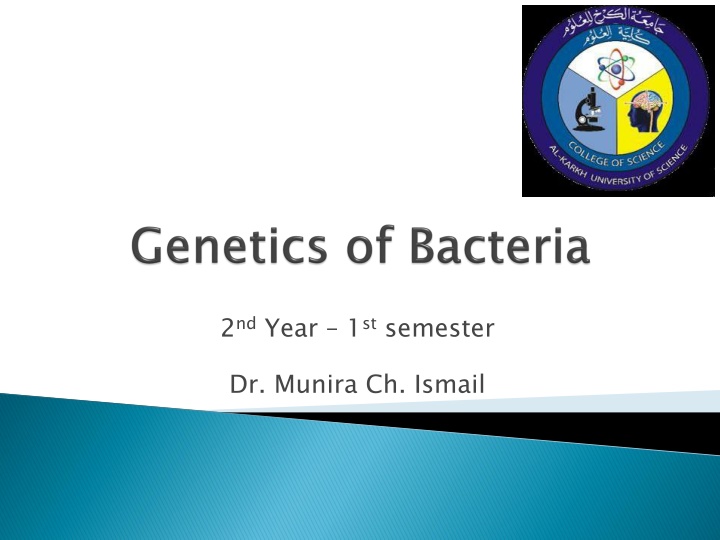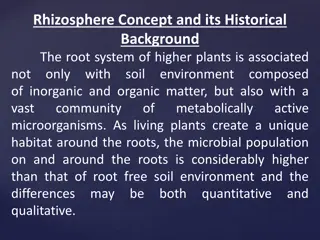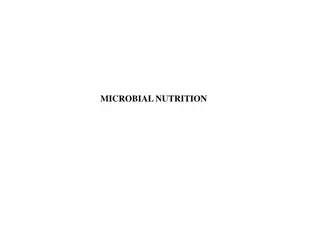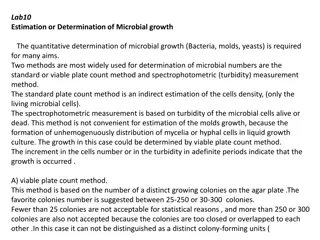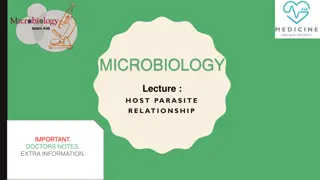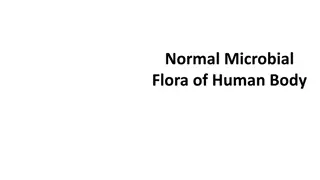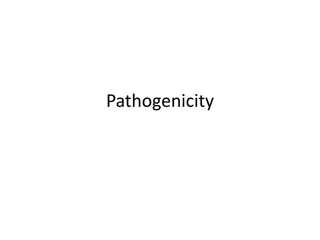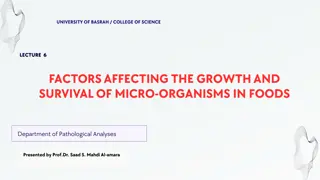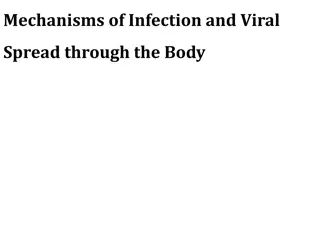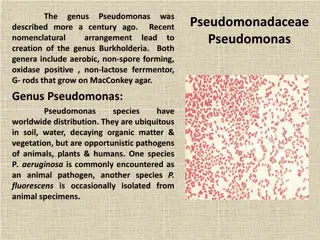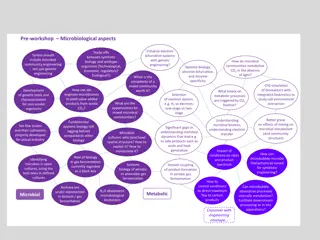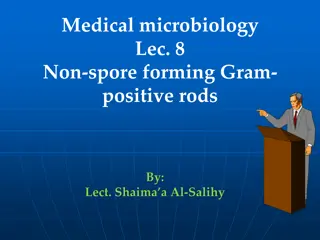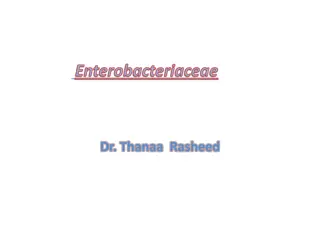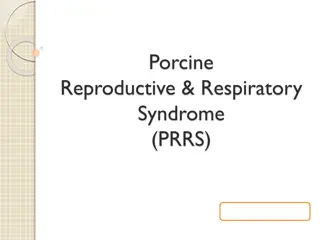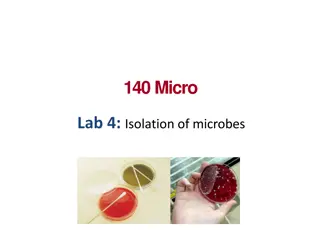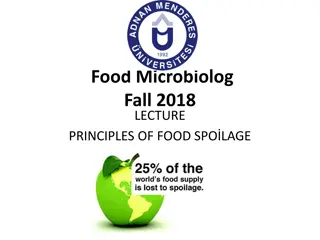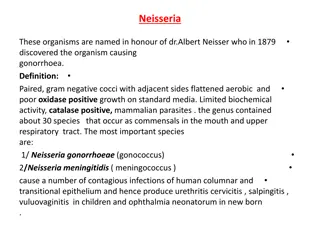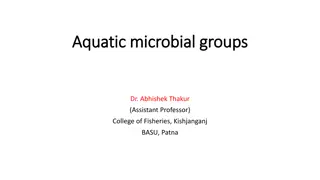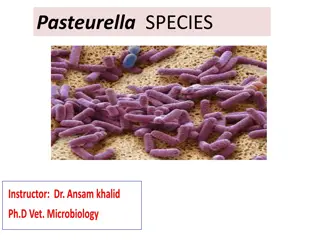Microbial Pathogenicity and Virulence Factors
Pathogenic microbes have the ability to cause infections by entering the host body, multiplying in tissues, damaging tissues, and evading host defenses. Factors such as invasiveness and toxigenesis play crucial roles in the development of bacterial diseases. Understanding these mechanisms is essential in studying microbial pathogenicity.
Download Presentation

Please find below an Image/Link to download the presentation.
The content on the website is provided AS IS for your information and personal use only. It may not be sold, licensed, or shared on other websites without obtaining consent from the author.If you encounter any issues during the download, it is possible that the publisher has removed the file from their server.
You are allowed to download the files provided on this website for personal or commercial use, subject to the condition that they are used lawfully. All files are the property of their respective owners.
The content on the website is provided AS IS for your information and personal use only. It may not be sold, licensed, or shared on other websites without obtaining consent from the author.
E N D
Presentation Transcript
2ndYear 1stsemester Dr. Munira Ch. Ismail
Microbial pathogenicity has been defined as either the structural and biochemical mechanisms where by microorganisms can cause disease or the infectious process and mechanisms that's leading to the development of signs and symptoms of bacterial disease. Pathogen microbes are highly pathogenic, whereas others cause disease rarely (low pathogenic). Virulence organism's genome is responsible forthe production of a virulence factor or part of a virulence pathway. Infection Multiplication of the bacteria that are part of the normal flora of the gastrointestinal tract, skin, and so on is generally not considered an infection; on the other hand, multiplication of pathogenic bacteria (eg, Salmonella species) even if the person is asymptomatic is deemed an infection. Infection, in general, is the presence and multiplication of microbe within host. Pathogen: : Microbe has ability to causing infection, some Virulence Gene Gene: : a gene whose presence or activity in an Infection: : Multiplication of an infectious agent within the body. Lec 9
1. Pathogenic organism should be able to enter the host body. 2. Pathogenic organism should be able to multiply in tissue. 3. Pathogenic organism should be able to damage the tissue. 4. They must be capable to resist the host defense. Lec 9
1. Invasiveness consists extracellular substances which facilitate invasion and ability to by pass or overcome host defense mechanisms. 2. .Toxigenesis Bacteria may produce two types of toxins called exotoxins and endotoxins. Exotoxins are released from bacterial cells and may act at tissue sites removed Endotoxins bacterial toxins, both soluble and cell-associated, may be transported by blood and lymph and cause cytotoxic effects at tissue sites remote from the original point of invasion or growth. Invasiveness is the ability to invade tissues. It of colonization, production of Toxigenesis is the ability to produce toxins. from are the cell-associated site of bacterial substance. growth. The Lec 9
Host personal hygiene and immune status; Underlying disease or medical condition; Antibiotic or drug usage; Presence of foreign object (e.g., splinter, catheter, sutures, etc.); Innate differences between hosts. Microbial External sanitation preparation; etc Mucous mucous membranes are respiratory tract, gastrointestinal tract, urinary/genital tracts and conjunctiva. Skin (keratinized cutaneous membrane):- Some pathogens infect hair follicles, sweat glands and colonize surface. But unless broken, skin is usually an impermeable barrier to microbes. Parenteral route: - penetrate skin, punctures, injections, bites, cuts, surgery and deposit organisms directly into deeper tissues. The microbes must enter through preferred portal of entry in order to causedisease. But some can cause disease from many routes of entry. . Host factors factors: : Age, sex, ethnicity, nutrition (diet), hormonal status; Microbial factors factors: : Bacterial virulence factors; Inoculum size (dosage) factors and (e.g., public crowding; health; seasonal food variations; hygiene, processing, storage and Mucous membrane membrane: : is most common route for most pathogens. The Lec 9
1 1- - Transmission from an external source into the portal of entry: The mode of transmission of many infectious diseases is : Animal to animal which occurs either by direct contact such as sexual or indirect contact such as fecal oral. Non animal source includes soil source, water source and insects. Animal to human either directly such as cat scratch fever or via insects vector such as lyme disease. Transmission from an external source into the portal of entry: Lec 9
Attachment/Adherence and host cells generally characterized by receptors and target sites. Surface both hosts (Receptor) and bacterial surfaces (Adhesins). Adhesins fimbriae as structural cell component; Host cell receptors are often sugar moieties. The lectins are adhesin specific for polysaccharide target receptor (sugar residues). Fimbriae extending outward from the surface of certain bacteria. Pili appendages extending outward from the surface of certain bacteria and responsible for bacterial conjugation Attachment/Adherence: : Close association of bacterial cells Surface Receptors/Target Receptors/Target Sites Sites: : Receptor sites present on Adhesins: : Bind Specific Host Receptors often involve Fimbriae (plural) (plural): : Short hair-like protein (pilin) appendages Pili (plural) (plural); ; Pilus (singular): Short hair-like protein (pilin) Lec 9
Biofilms to a surface which usually moist and contains organic glycocalyx allowing other microbes to adhere a large mass is formed. The biofilms are resistant to disinfectants and antibiotics. Biofilms: : - are formed when microbes adhere matter. The microbe secretes Lec 9
Is the ability of a pathogen to invade host tissues. Invasiveness encompasses (1) mechanisms for colonization (adherence and initial multiplication), (2) production of extracellular substances ("invasins"), invasion of tissues and (3) defense actual invasive process. that promote the immediate ability to bypass or overcome facilitate host the mechanisms which Lec 9
Is substances soluble transported by blood and lymph and cause cytotoxic effects at tissue sites remote from the original point of invasion or growth. the ability to produce toxins. bacteria, Toxic both produced and by cell-associated, may be Lec 9
Pathogens have developed mechanisms to evade the phagocytes in the immune system by many there inflammatory mobility, and "trick" the immune system into thinking the bacteria is a "self" cell. ways such as grow in areas where no response, are phagocytes, suppress inhibit the phagocyte Lec 9
The chances of causing diseases increase as the numbers of invading pathogens increases. This expressed by infectious dose (ID50) and lethal dose (LD50). The ID50 (Infectious Dose) is the number infection in 50% of the population. The ID50 is different for different pathogens i.e. different ID50 for different portals of entry for the same pathogen. The LD50 (Lethal Dose) amount of toxin or pathogen necessary to kill 50% of the population in a particular time frame. of microbes required to produce Lec 9
A A. . Adherence mucosal sites by using pili (fimbriae) to adhere to cells. A fimbriae is a hair like appendages ( short pilus) found on the surface of many bacteria, that is used to attach the bacterium to a surface. See the following figure: B B. . Invasion virulence factors such as microbial adherence, resistance to antimicrobials, and defects in host defense mechanisms. C C. . Capsules polysaccharide layer that lies outside the cell wall of bacteria. Capsule mediate adherence of pathogen to specific receptors on host cell surface. so that it prevent the phagocytes from adhering to bacteria, therefore act as antiphagocytic factor. D D. . Enzymes the pathogenesis of bacteria which facilitate local tissue damage such as elastase, ect.). Adherence Factors Factors: Many pathogenic bacteria colonize Invasion Factors Factors: : Microbial invasion can be facilitated by Capsules: Many bacteria are surrounded by capsules, it is a Enzymes: : Several enzymes secreted by bacteria play a role in ( protease, hyaluronidase, coagulase, Lec 9
E E. . Toxins generally classified into two groups: 1. Endotoxins - negative bacteria. Released on bacterial death and polysaccharides of gram negative bacteria. 2. Exotoxins and gram positive bacteria. There are several types of protein toxins and enzymes produced and /or secreted from pathogenic bacteria. Major categories include cytotoxins, neurotoxins, and enterotoxins. F F. . Siderophores factors that allow some bacteria to compete with the host for iron, which is bound to hemoglobin, transferrin, and lactoferrin such as P.aeruginosa. Toxins: : Toxins produced by bacteria are Endotoxins: Integral part of the cell wall of gram in part during growth such as Exotoxins: Excreted by both gram - negative Siderophores: : Siderophores are iron-binding Lec 9
